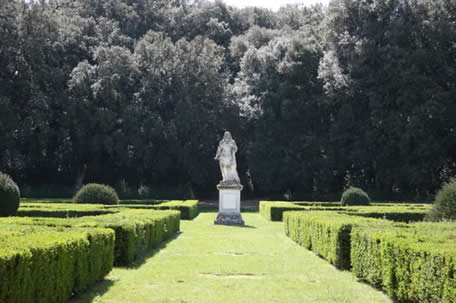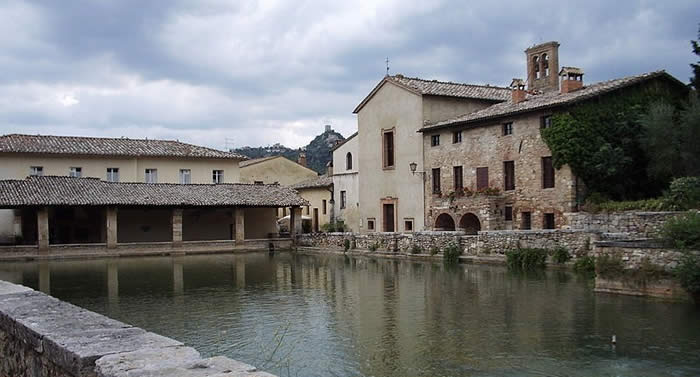INDEX
1. SIENA - MUSEUMS AND SECULAR BUILDINGS
3. PLACES WITHIN HALF AN HOUR OF BARONTOLI
6. SIENESE PAINTERS
7. SAINTS IN ART
PLACES FURTHER AFIELD
SAN QUIRICO D'ORCIA
An unspoilt small town with a beautiful Romanesque church and no tourist razzmatazz. Town plan available from tourist office opposite the Palazzo Chigi in the main street. Also worth visiting briefly are the nearby Bagno Vignoni, Rocca d’Orcia and Castiglione d’Orcia.
The little town of San Quirico d’Orcia, half-way between Montalcino and Pienza, is usually by-passed by tourists; yet it contains several lovely things. Situated on what was one of the main roads between the Northern Italian states and Rome - indeed one of the main pilgrims' ways to Rome (the via Francigena) - it used in the past to be a major stopping place for important people on their way south. The first recorded distinguished traveller to stay there was an early Archbishop of Canterbury, Sigeric, in 990. The most famous visitor was the Holy Roman Emperor, Frederick Barbarossa, who camped there in 1154 when on his way to Rome to be crowned by the Pope, and there is still a festival every year in honour of his visit, the "Festa del Barbarossa", on the third Sunday in June.
San Quirico still has much of its original fortified walls, with traces of some 14 small towers and three gates - the best preserved is the Porta Cappuccini, a strange polygonal structure. But the town’s main sights are three attractive churches, strung out along the main street.
The Collegiate Church or Collegiata (open 08.00-12.00 and 16.00-19.00 except Sundays), the best of the three, is the first that you come to on entering the town from the direction of Siena. It is an attractive Romanesque-turning-to-Gothic structure dating from the 12th and 13th centuries, with three excellent carved doorways. The striking main door, which greets and draws on the visitor entering the town, is pure Romanesque and is attributed to Giovanni Pisano. It is carved mainly of white travertine, but some of the animals and pillars are of a darker, brownish stone, unfortunately softer and therefore more worn. The two crocodile-like dragons over the door, however, are still excellently preserved. The other two doors, on the side of the church, show signs of the transition to Gothic, but the middle one in particular still has much interesting carving, with figures attributed again to Giovanni Pisano. Note also the tiny figure carved in the corner of the window on this side.
Door on the side of the Collegiata
Inside, the Romanesque interior is somewhat marred by an awkward baroque altar. But the church contains two treasures, a tryptich (1470) by Sano di Pietro, and quite magnificent marquetry stalls. The tryptich (light switch on the left) shows the Virgin and Child surrounded by saints; St John the Baptist and San Quirico on the left and St Fortunatus and St John the Evangelist on the right, and two tiny donors below. St Quirico was a Jew who was said to have revealed the hiding-place of the true Cross to St Helena, and he holds the nails from the cross. Despite these gory symbols, and the head on a plate carried by St Fortunatus, the figures have a quiet and serene look. Note also the sumptuous robes of the Virgin and the decorative marble floor with a carpet under the throne.
The other high-light of the church is the set of the magnificent inlaid panels behind the altar, which were originally made for the Duomo in Siena. They date from between 1482 and 1502 and are by the Sienese artist Antonio Barili. There are seven scenes, all with great character, some of the best examples of the Italian art of "painting" with wood. Unfortunately, the altar area has been roped off and the stalls can only be seen by stepping illegally over the rope.
Also worth a glance, on the left of the nave, is the handsome marble tomb of another noble medieval visitor to San Quirico, the German Count Henry of Nassau, who died here while on his way to Rome in 1451.
Next to the Collegiata, the Palazzo Chigi is a fine if dilapidated 17th century villa built by Cardinal Flavio Chigi, a nephew of the then Pope, to whom the Grand Duke Cosimo III Medici of Florence (who had himself recently taken possession of the town) had granted the Marquisate of San Quirico (the sort of thing that happened to papal nephews). Further down the main street, also on the left, is another church, San Francesco (also known as Chiesa della Madonna). It has been messed about with architecturally and its interior is now elegant Renaissance in style. It has a rather beautiful white terracotta Madonna on the main altar, attributed to Andrea della Robbia - it may be part of a pair making an Annunciation scene, as it is rare to see the Virgin alone without the child unless she is either meeting the archangel Gabriel or being assumed into heaven. There are also two 15th century painted wooden statues - this time a complete Annunciation set, with both the Virgin and the angel - attributed to a pupil of Jacopo della Quercia.
Opposite San Francesco, there is a way through into the Horti Leonini (Leonini Gardens), a good example of a formal 16th century Italian garden. It was created in 1580 by one Diomede Leoni for the comfort and convenience of the noble travellers who passed through San Quirico (an American writer, Patricia McCobb, has written a book about the creation of the garden). There is usually an exhibition of modern sculpture dotted around the garden, but also one older and permanent statue in the middle, of Grand Duke Cosimo Medici III of Florence, sculpted in 1688 by Bartolomeo Mazzuoli on the orders of Cardinal Flavio Chigi. Open daily 09.00-20.00 March-October, and 10.00-17.00 in winter.

Horti Leonini with staue of Grand Duke Cosimo III (Photo Wikimedia Commons).
At No. 38 on the main street there is a gothic house where St Catherine of Siena was said to have resided during a stay in San Quirico. Further along the main street on the right, almost at the end of the town, is the tiny Romanesque church of Santa Maria Assunta (St Mary of the Assumption). It is very early, built probably at the beginning of the 10th century, and is an unspoilt example of the simplest sort of one-aisled Romanesque church, almost the only decorative feature being the porch, which is said to have come from the Abbey of San Antimo. On the other side of the street, there was a hostel or hospice in medieval times for pilgrims and travellers on their way to or from Rome (Ospedale della Scala di San Quirico), but nothing there is now worth stopping for.
Santa Maria Assunta.
Bagno Vignoni

(Photo Wikimedia Commons)
This village near San Quirico has been known for its thermal baths since Roman times. Hot mineral water wells up into a pretty pool in the centre of the village, and then descends to the various spa hotels and warm pools on the slopes below. The central pool is now out of bounds for bathing, but especially in the 14th and 15th centuries many distinguished visitors came to take the waters, including Lorenzo il Magnifico, the Sienese Pope Pius II Piccolomini and St Catherine of Siena. In those days there were separate bathing areas for men and women. The current large pool was the men’s area; the much smaller women’s pool was on the other side of the Renaissance arcade along the end of the pool. There are several cafés and restaurants around and near the pool, but they are rather chi-chi and it is best to eat in San Quirico.
Rocca d’Orcia

Photo Wikimedia Commons
A little further south there is a tiny medieval village or “borgo” called Rocca d’Orcia, and above it a massive “Rocca” – a formidable and vertiginous medieval fortress built on top of a high rock, with no apparent entrance, visible for miles around, known as the Rocca Tentennano. This was one of the most important and impregnable strong-points on the via Francigena pilgrim route from Northern Europe to Rome. It dates back at least to the ninth century, although it has been much rebuilt over the ages. One can climb to the top of the fortress to obtain perhaps the most spectacular panoramic view in the whole of the Senese – a province of spectacular views. There is usually an exhibition of modern art in the vaulted room on the bottom floor of the fortress. A ticket is needed to get access; the opening hours (in 2013) are 10.00-13.00 and 15.00-18.00, every day in summer but only weekends in winter.
Castiglione d’Orcia
Next to Rocca D’Orcia, there is a bigger village called Castiglione D’Orcia with a pretty central square. It is overlooked by the ruined Castello degli Aldobrandeschi, a rival to the Rocca. Recently, the Oratory of St John the Baptist in Castiglione has been opened as a small art gallery (Sala d’Arte) to house various paintings from the churches round about. The village is the home of the 15th century Sienese artist Lorenzo di Pietro (generally known as Il Vecchietta) and the collection includes a painting by him of the Madonna being crowned by Angels, unfortunately somewhat damaged in its lower portion. There is also a Virgin and Child attributed to Simone Martini and workshop (probably mainly workshop), recently retrieved from the museum in Montalcino; and a good Madonna nursing the Christchild by Giovanni di Paolo. Unfortunately, the gallery is only open at weekends at present (2013).
There are various eating places in both Rocca d’Orcia and Castiglione d’Orcia.
(1991, revised 2013)